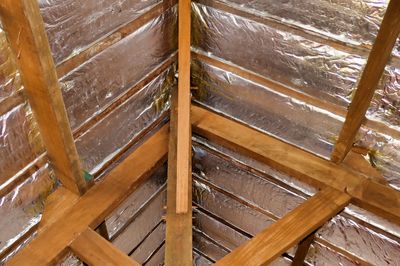Signed in as:
filler@godaddy.com
Signed in as:
filler@godaddy.com
Attic radiant barriers are reflective materials installed in the attic to reduce radiant heat transfer from the roof into the living space. They are most effective in hot climates and in attics with unsealed air gaps or vented roofs. Here’s what they can do for you:
1) Reduced Cooling Load
Lower heat gain from the roof:** Radiant barriers reflect a large portion of solar radiation away from the attic, reducing the amount of heat that moves into living spaces.
HVAC efficiency improvement:** With less radiant heat entering the home, air conditioners can run less frequently or at lower speeds, potentially lowering cooling costs.
2) Improved Comfort
Quicker cooling response:** Intermittent or peak heat periods feel less intense because the attic stays cooler.
More even temperatures:** Reducing attic heat can help keep upper-floor rooms from getting excessively hot.
3) Potential for Energy Savings
Incremental savings in hot climates:** Savings depend on climate, attic ventilation, insulation levels, and existing roof architecture.
Works best with other measures:** Maximum benefit when combined with proper insulation, air sealing, and good attic ventilation.
4) Moisture and Condensation Considerations
Ventilation still key:** Radiant barriers do not replace proper ventilation. Inadequate ventilation can cause moisture buildup; ensure vents and soffits remain open and balanced.
Not a moisture barrier:** They primarily reduce heat transfer, not moisture; decouple moisture control from radiant heat management as needed.
5) Fire Safety and Installation
Non-combustible options often recommended:** Use materials that meet local fire codes and are rated for attic use.
Professional installation is common:** Proper installation ensures the barrier has an air gap from the roof deck and is not compressed, which would reduce effectiveness.
When Radiant Barriers Make Sense
Best suited for hot, sunny climates with uninsulated or lightly insulated attics.
Attics with existing good air sealing and ventilation can see more consistent results when a radiant barrier is added.
When insulating higher R-values, radiant barriers can complement insulation by reducing heat gain.
Quick Comparison: Radiant Barrier vs Attic Insulation
Radiant barrier:** Reflects radiant heat, works best in hot climates, less impact on conduction through attic surfaces.
Attic insulation ( fiberglass, mineral wool, cellulose, spray foam):** Slows conductive heat transfer, provides year-round savings, typically more impactful for overall energy bills in diverse climates.
Practical Tips
Check local climate considerations and energy codes to determine expected savings.
If choosing both, install radiant barrier with proper attic ventilation and preserve airflow.
Get a professional assessment to confirm that your attic is suitable (no existing moisture problems, structural clearance, code compliance).
If you’d like, tell me your location (climate zone), attic type (vented vs. unvented), current insulation level, and any moisture concerns. I can estimate potential savings, likely effectiveness, and installation considerations tailored to your home.

We use cookies to analyze website traffic and optimize your website experience. By accepting our use of cookies, your data will be aggregated with all other user data.